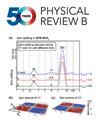András L. Szabó, Bitan Roy
求助PDF
{"title":"三维相互作用掺杂拓扑绝缘体中的超导现象","authors":"András L. Szabó, Bitan Roy","doi":"10.1103/physrevb.110.l201301","DOIUrl":null,"url":null,"abstract":"Three-dimensional doped Dirac insulators foster simply connected (in both topological and trivial regimes) and annular (deep inside the topological regime) Fermi surfaces (FSs) in the normal state, and allow on-site repulsions among fermions with opposite spin (<mjx-container ctxtmenu_counter=\"20\" ctxtmenu_oldtabindex=\"1\" jax=\"CHTML\" overflow=\"linebreak\" role=\"tree\" sre-explorer- style=\"font-size: 100.7%;\" tabindex=\"0\"><mjx-math data-semantic-structure=\"(2 0 1)\"><mjx-msub data-semantic-children=\"0,1\" data-semantic- data-semantic-owns=\"0 1\" data-semantic-role=\"latinletter\" data-semantic-speech=\"upper U 1\" data-semantic-type=\"subscript\"><mjx-mi data-semantic-annotation=\"clearspeak:simple\" data-semantic-font=\"italic\" data-semantic- data-semantic-parent=\"2\" data-semantic-role=\"latinletter\" data-semantic-type=\"identifier\"><mjx-c>𝑈</mjx-c></mjx-mi><mjx-script style=\"vertical-align: -0.15em; margin-left: -0.071em;\"><mjx-mn data-semantic-annotation=\"clearspeak:simple\" data-semantic-font=\"normal\" data-semantic- data-semantic-parent=\"2\" data-semantic-role=\"integer\" data-semantic-type=\"number\" size=\"s\"><mjx-c>1</mjx-c></mjx-mn></mjx-script></mjx-msub></mjx-math></mjx-container>) and parity (<mjx-container ctxtmenu_counter=\"21\" ctxtmenu_oldtabindex=\"1\" jax=\"CHTML\" overflow=\"linebreak\" role=\"tree\" sre-explorer- style=\"font-size: 100.7%;\" tabindex=\"0\"><mjx-math data-semantic-structure=\"(2 0 1)\"><mjx-msub data-semantic-children=\"0,1\" data-semantic- data-semantic-owns=\"0 1\" data-semantic-role=\"latinletter\" data-semantic-speech=\"upper U 2\" data-semantic-type=\"subscript\"><mjx-mi data-semantic-annotation=\"clearspeak:simple\" data-semantic-font=\"italic\" data-semantic- data-semantic-parent=\"2\" data-semantic-role=\"latinletter\" data-semantic-type=\"identifier\"><mjx-c>𝑈</mjx-c></mjx-mi><mjx-script style=\"vertical-align: -0.15em; margin-left: -0.071em;\"><mjx-mn data-semantic-annotation=\"clearspeak:simple\" data-semantic-font=\"normal\" data-semantic- data-semantic-parent=\"2\" data-semantic-role=\"integer\" data-semantic-type=\"number\" size=\"s\"><mjx-c>2</mjx-c></mjx-mn></mjx-script></mjx-msub></mjx-math></mjx-container>) eigenvalues. From an unbiased leading-order (one-loop) renormalization group analysis, controlled by a suitable <mjx-container ctxtmenu_counter=\"22\" ctxtmenu_oldtabindex=\"1\" jax=\"CHTML\" overflow=\"linebreak\" role=\"tree\" sre-explorer- style=\"font-size: 100.7%;\" tabindex=\"0\"><mjx-math data-semantic-structure=\"0\"><mjx-mi data-semantic-annotation=\"clearspeak:simple\" data-semantic-font=\"italic\" data-semantic- data-semantic-role=\"greekletter\" data-semantic-speech=\"epsilon\" data-semantic-type=\"identifier\"><mjx-c>𝜀</mjx-c></mjx-mi></mjx-math></mjx-container> expansion, we show that this system develops a strong propensity toward the nucleation of scalar <mjx-container ctxtmenu_counter=\"23\" ctxtmenu_oldtabindex=\"1\" jax=\"CHTML\" overflow=\"linebreak\" role=\"tree\" sre-explorer- style=\"font-size: 100.7%;\" tabindex=\"0\"><mjx-math data-semantic-structure=\"0\"><mjx-mi data-semantic-annotation=\"clearspeak:simple\" data-semantic-font=\"italic\" data-semantic- data-semantic-role=\"latinletter\" data-semantic-speech=\"s\" data-semantic-type=\"identifier\"><mjx-c>𝑠</mjx-c></mjx-mi></mjx-math></mjx-container>-wave and odd-parity pseudoscalar <mjx-container ctxtmenu_counter=\"24\" ctxtmenu_oldtabindex=\"1\" jax=\"CHTML\" overflow=\"linebreak\" role=\"tree\" sre-explorer- style=\"font-size: 100.7%;\" tabindex=\"0\"><mjx-math data-semantic-structure=\"0\"><mjx-mi data-semantic-annotation=\"clearspeak:simple\" data-semantic-font=\"italic\" data-semantic- data-semantic-role=\"latinletter\" data-semantic-speech=\"p\" data-semantic-type=\"identifier\"><mjx-c>𝑝</mjx-c></mjx-mi></mjx-math></mjx-container>-wave pairings, favored by repulsive <mjx-container ctxtmenu_counter=\"25\" ctxtmenu_oldtabindex=\"1\" jax=\"CHTML\" overflow=\"linebreak\" role=\"tree\" sre-explorer- style=\"font-size: 100.7%;\" tabindex=\"0\"><mjx-math data-semantic-structure=\"(2 0 1)\"><mjx-msub data-semantic-children=\"0,1\" data-semantic- data-semantic-owns=\"0 1\" data-semantic-role=\"latinletter\" data-semantic-speech=\"upper U 1\" data-semantic-type=\"subscript\"><mjx-mi data-semantic-annotation=\"clearspeak:simple\" data-semantic-font=\"italic\" data-semantic- data-semantic-parent=\"2\" data-semantic-role=\"latinletter\" data-semantic-type=\"identifier\"><mjx-c>𝑈</mjx-c></mjx-mi><mjx-script style=\"vertical-align: -0.15em; margin-left: -0.071em;\"><mjx-mn data-semantic-annotation=\"clearspeak:simple\" data-semantic-font=\"normal\" data-semantic- data-semantic-parent=\"2\" data-semantic-role=\"integer\" data-semantic-type=\"number\" size=\"s\"><mjx-c>1</mjx-c></mjx-mn></mjx-script></mjx-msub></mjx-math></mjx-container> and <mjx-container ctxtmenu_counter=\"26\" ctxtmenu_oldtabindex=\"1\" jax=\"CHTML\" overflow=\"linebreak\" role=\"tree\" sre-explorer- style=\"font-size: 100.7%;\" tabindex=\"0\"><mjx-math data-semantic-structure=\"(2 0 1)\"><mjx-msub data-semantic-children=\"0,1\" data-semantic- data-semantic-owns=\"0 1\" data-semantic-role=\"latinletter\" data-semantic-speech=\"upper U 2\" data-semantic-type=\"subscript\"><mjx-mi data-semantic-annotation=\"clearspeak:simple\" data-semantic-font=\"italic\" data-semantic- data-semantic-parent=\"2\" data-semantic-role=\"latinletter\" data-semantic-type=\"identifier\"><mjx-c>𝑈</mjx-c></mjx-mi><mjx-script style=\"vertical-align: -0.15em; margin-left: -0.071em;\"><mjx-mn data-semantic-annotation=\"clearspeak:simple\" data-semantic-font=\"normal\" data-semantic- data-semantic-parent=\"2\" data-semantic-role=\"integer\" data-semantic-type=\"number\" size=\"s\"><mjx-c>2</mjx-c></mjx-mn></mjx-script></mjx-msub></mjx-math></mjx-container> interactions, respectively, irrespective of the underlying FS topology. Our results can be pertinent for the observed superconductivity in various doped narrow gap semiconductors, and the theoretical foundation can readily be applied to investigate similar phenomenon in various doped topological materials.","PeriodicalId":20082,"journal":{"name":"Physical Review B","volume":null,"pages":null},"PeriodicalIF":3.7000,"publicationDate":"2024-11-04","publicationTypes":"Journal Article","fieldsOfStudy":null,"isOpenAccess":false,"openAccessPdf":"","citationCount":"0","resultStr":"{\"title\":\"Superconductivity in three-dimensional interacting doped topological insulators\",\"authors\":\"András L. Szabó, Bitan Roy\",\"doi\":\"10.1103/physrevb.110.l201301\",\"DOIUrl\":null,\"url\":null,\"abstract\":\"Three-dimensional doped Dirac insulators foster simply connected (in both topological and trivial regimes) and annular (deep inside the topological regime) Fermi surfaces (FSs) in the normal state, and allow on-site repulsions among fermions with opposite spin (<mjx-container ctxtmenu_counter=\\\"20\\\" ctxtmenu_oldtabindex=\\\"1\\\" jax=\\\"CHTML\\\" overflow=\\\"linebreak\\\" role=\\\"tree\\\" sre-explorer- style=\\\"font-size: 100.7%;\\\" tabindex=\\\"0\\\"><mjx-math data-semantic-structure=\\\"(2 0 1)\\\"><mjx-msub data-semantic-children=\\\"0,1\\\" data-semantic- data-semantic-owns=\\\"0 1\\\" data-semantic-role=\\\"latinletter\\\" data-semantic-speech=\\\"upper U 1\\\" data-semantic-type=\\\"subscript\\\"><mjx-mi data-semantic-annotation=\\\"clearspeak:simple\\\" data-semantic-font=\\\"italic\\\" data-semantic- data-semantic-parent=\\\"2\\\" data-semantic-role=\\\"latinletter\\\" data-semantic-type=\\\"identifier\\\"><mjx-c>𝑈</mjx-c></mjx-mi><mjx-script style=\\\"vertical-align: -0.15em; margin-left: -0.071em;\\\"><mjx-mn data-semantic-annotation=\\\"clearspeak:simple\\\" data-semantic-font=\\\"normal\\\" data-semantic- data-semantic-parent=\\\"2\\\" data-semantic-role=\\\"integer\\\" data-semantic-type=\\\"number\\\" size=\\\"s\\\"><mjx-c>1</mjx-c></mjx-mn></mjx-script></mjx-msub></mjx-math></mjx-container>) and parity (<mjx-container ctxtmenu_counter=\\\"21\\\" ctxtmenu_oldtabindex=\\\"1\\\" jax=\\\"CHTML\\\" overflow=\\\"linebreak\\\" role=\\\"tree\\\" sre-explorer- style=\\\"font-size: 100.7%;\\\" tabindex=\\\"0\\\"><mjx-math data-semantic-structure=\\\"(2 0 1)\\\"><mjx-msub data-semantic-children=\\\"0,1\\\" data-semantic- data-semantic-owns=\\\"0 1\\\" data-semantic-role=\\\"latinletter\\\" data-semantic-speech=\\\"upper U 2\\\" data-semantic-type=\\\"subscript\\\"><mjx-mi data-semantic-annotation=\\\"clearspeak:simple\\\" data-semantic-font=\\\"italic\\\" data-semantic- data-semantic-parent=\\\"2\\\" data-semantic-role=\\\"latinletter\\\" data-semantic-type=\\\"identifier\\\"><mjx-c>𝑈</mjx-c></mjx-mi><mjx-script style=\\\"vertical-align: -0.15em; margin-left: -0.071em;\\\"><mjx-mn data-semantic-annotation=\\\"clearspeak:simple\\\" data-semantic-font=\\\"normal\\\" data-semantic- data-semantic-parent=\\\"2\\\" data-semantic-role=\\\"integer\\\" data-semantic-type=\\\"number\\\" size=\\\"s\\\"><mjx-c>2</mjx-c></mjx-mn></mjx-script></mjx-msub></mjx-math></mjx-container>) eigenvalues. From an unbiased leading-order (one-loop) renormalization group analysis, controlled by a suitable <mjx-container ctxtmenu_counter=\\\"22\\\" ctxtmenu_oldtabindex=\\\"1\\\" jax=\\\"CHTML\\\" overflow=\\\"linebreak\\\" role=\\\"tree\\\" sre-explorer- style=\\\"font-size: 100.7%;\\\" tabindex=\\\"0\\\"><mjx-math data-semantic-structure=\\\"0\\\"><mjx-mi data-semantic-annotation=\\\"clearspeak:simple\\\" data-semantic-font=\\\"italic\\\" data-semantic- data-semantic-role=\\\"greekletter\\\" data-semantic-speech=\\\"epsilon\\\" data-semantic-type=\\\"identifier\\\"><mjx-c>𝜀</mjx-c></mjx-mi></mjx-math></mjx-container> expansion, we show that this system develops a strong propensity toward the nucleation of scalar <mjx-container ctxtmenu_counter=\\\"23\\\" ctxtmenu_oldtabindex=\\\"1\\\" jax=\\\"CHTML\\\" overflow=\\\"linebreak\\\" role=\\\"tree\\\" sre-explorer- style=\\\"font-size: 100.7%;\\\" tabindex=\\\"0\\\"><mjx-math data-semantic-structure=\\\"0\\\"><mjx-mi data-semantic-annotation=\\\"clearspeak:simple\\\" data-semantic-font=\\\"italic\\\" data-semantic- data-semantic-role=\\\"latinletter\\\" data-semantic-speech=\\\"s\\\" data-semantic-type=\\\"identifier\\\"><mjx-c>𝑠</mjx-c></mjx-mi></mjx-math></mjx-container>-wave and odd-parity pseudoscalar <mjx-container ctxtmenu_counter=\\\"24\\\" ctxtmenu_oldtabindex=\\\"1\\\" jax=\\\"CHTML\\\" overflow=\\\"linebreak\\\" role=\\\"tree\\\" sre-explorer- style=\\\"font-size: 100.7%;\\\" tabindex=\\\"0\\\"><mjx-math data-semantic-structure=\\\"0\\\"><mjx-mi data-semantic-annotation=\\\"clearspeak:simple\\\" data-semantic-font=\\\"italic\\\" data-semantic- data-semantic-role=\\\"latinletter\\\" data-semantic-speech=\\\"p\\\" data-semantic-type=\\\"identifier\\\"><mjx-c>𝑝</mjx-c></mjx-mi></mjx-math></mjx-container>-wave pairings, favored by repulsive <mjx-container ctxtmenu_counter=\\\"25\\\" ctxtmenu_oldtabindex=\\\"1\\\" jax=\\\"CHTML\\\" overflow=\\\"linebreak\\\" role=\\\"tree\\\" sre-explorer- style=\\\"font-size: 100.7%;\\\" tabindex=\\\"0\\\"><mjx-math data-semantic-structure=\\\"(2 0 1)\\\"><mjx-msub data-semantic-children=\\\"0,1\\\" data-semantic- data-semantic-owns=\\\"0 1\\\" data-semantic-role=\\\"latinletter\\\" data-semantic-speech=\\\"upper U 1\\\" data-semantic-type=\\\"subscript\\\"><mjx-mi data-semantic-annotation=\\\"clearspeak:simple\\\" data-semantic-font=\\\"italic\\\" data-semantic- data-semantic-parent=\\\"2\\\" data-semantic-role=\\\"latinletter\\\" data-semantic-type=\\\"identifier\\\"><mjx-c>𝑈</mjx-c></mjx-mi><mjx-script style=\\\"vertical-align: -0.15em; margin-left: -0.071em;\\\"><mjx-mn data-semantic-annotation=\\\"clearspeak:simple\\\" data-semantic-font=\\\"normal\\\" data-semantic- data-semantic-parent=\\\"2\\\" data-semantic-role=\\\"integer\\\" data-semantic-type=\\\"number\\\" size=\\\"s\\\"><mjx-c>1</mjx-c></mjx-mn></mjx-script></mjx-msub></mjx-math></mjx-container> and <mjx-container ctxtmenu_counter=\\\"26\\\" ctxtmenu_oldtabindex=\\\"1\\\" jax=\\\"CHTML\\\" overflow=\\\"linebreak\\\" role=\\\"tree\\\" sre-explorer- style=\\\"font-size: 100.7%;\\\" tabindex=\\\"0\\\"><mjx-math data-semantic-structure=\\\"(2 0 1)\\\"><mjx-msub data-semantic-children=\\\"0,1\\\" data-semantic- data-semantic-owns=\\\"0 1\\\" data-semantic-role=\\\"latinletter\\\" data-semantic-speech=\\\"upper U 2\\\" data-semantic-type=\\\"subscript\\\"><mjx-mi data-semantic-annotation=\\\"clearspeak:simple\\\" data-semantic-font=\\\"italic\\\" data-semantic- data-semantic-parent=\\\"2\\\" data-semantic-role=\\\"latinletter\\\" data-semantic-type=\\\"identifier\\\"><mjx-c>𝑈</mjx-c></mjx-mi><mjx-script style=\\\"vertical-align: -0.15em; margin-left: -0.071em;\\\"><mjx-mn data-semantic-annotation=\\\"clearspeak:simple\\\" data-semantic-font=\\\"normal\\\" data-semantic- data-semantic-parent=\\\"2\\\" data-semantic-role=\\\"integer\\\" data-semantic-type=\\\"number\\\" size=\\\"s\\\"><mjx-c>2</mjx-c></mjx-mn></mjx-script></mjx-msub></mjx-math></mjx-container> interactions, respectively, irrespective of the underlying FS topology. Our results can be pertinent for the observed superconductivity in various doped narrow gap semiconductors, and the theoretical foundation can readily be applied to investigate similar phenomenon in various doped topological materials.\",\"PeriodicalId\":20082,\"journal\":{\"name\":\"Physical Review B\",\"volume\":null,\"pages\":null},\"PeriodicalIF\":3.7000,\"publicationDate\":\"2024-11-04\",\"publicationTypes\":\"Journal Article\",\"fieldsOfStudy\":null,\"isOpenAccess\":false,\"openAccessPdf\":\"\",\"citationCount\":\"0\",\"resultStr\":null,\"platform\":\"Semanticscholar\",\"paperid\":null,\"PeriodicalName\":\"Physical Review B\",\"FirstCategoryId\":\"101\",\"ListUrlMain\":\"https://doi.org/10.1103/physrevb.110.l201301\",\"RegionNum\":2,\"RegionCategory\":\"物理与天体物理\",\"ArticlePicture\":[],\"TitleCN\":null,\"AbstractTextCN\":null,\"PMCID\":null,\"EPubDate\":\"\",\"PubModel\":\"\",\"JCR\":\"Q1\",\"JCRName\":\"Physics and Astronomy\",\"Score\":null,\"Total\":0}","platform":"Semanticscholar","paperid":null,"PeriodicalName":"Physical Review B","FirstCategoryId":"101","ListUrlMain":"https://doi.org/10.1103/physrevb.110.l201301","RegionNum":2,"RegionCategory":"物理与天体物理","ArticlePicture":[],"TitleCN":null,"AbstractTextCN":null,"PMCID":null,"EPubDate":"","PubModel":"","JCR":"Q1","JCRName":"Physics and Astronomy","Score":null,"Total":0}
引用次数: 0
引用
批量引用

 求助内容:
求助内容: 应助结果提醒方式:
应助结果提醒方式:


